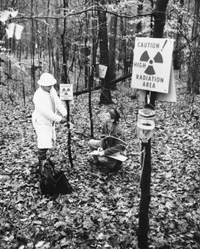|
“Our species
is simply the semblance-seeing creature; with our
minds, we place disparate things side by side and
watch what happens. Sometimes nothing, sometimes
a fizz, sometimes an explosion.…”
 In
the late 1950s, professor Robert Petty used radioactive
isotopes to study the energy pathways within the
forest ecosystems of Allee Woods, a college property
south of Crawfordsville. It was the height of the
Cold War, and the Atomic Energy Commission, interested
in how radioactivity moved through living systems,
funded Petty’s research for reasons different
than his own. In
the late 1950s, professor Robert Petty used radioactive
isotopes to study the energy pathways within the
forest ecosystems of Allee Woods, a college property
south of Crawfordsville. It was the height of the
Cold War, and the Atomic Energy Commission, interested
in how radioactivity moved through living systems,
funded Petty’s research for reasons different
than his own.
For a while, Petty
was at a loss about how to deliver these isotopes
to the trees. Then a solution presented itself to
him almost out of the blue.
Petty was suffering
another serious bout with Crohn’s Disease
when he found himself waking up, groggy, on an IV
drip. Still half asleep, he whispered, “Aha!”
to himself and dozed off again.
When he was better,
he went out to the woods with an IV bottle and plastic
tubing. He bored a small hole through the bark and
into the vascular tissue of a tree, slapped some
aquarium cement at the juncture of tree and tubing,
filled the bottle with a solution of his isotope,
and hung it from a nearby branch, putting the tree
on an IV drip.
As I think about
it, the story is a parable of Petty’s mind.
He saw himself as a tree, he thought like a tree.
He had the poet’s metaphorical cast of mind.
But I don’t think he would have approved of
that last sentence. Scientists coin metaphors too.
Our species is simply
the semblance-seeing creature; with our minds, we
place disparate things side by side and watch what
happens. Sometimes nothing, sometimes a fizz, sometimes
an explosion. Good scientists and good poets know
this.
|